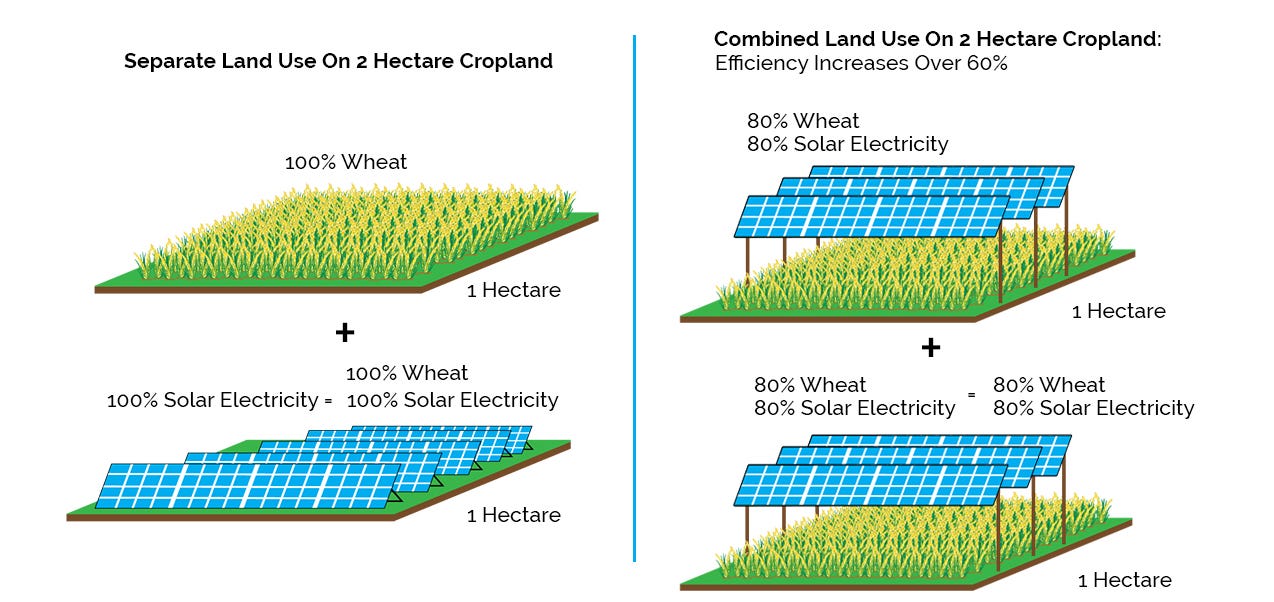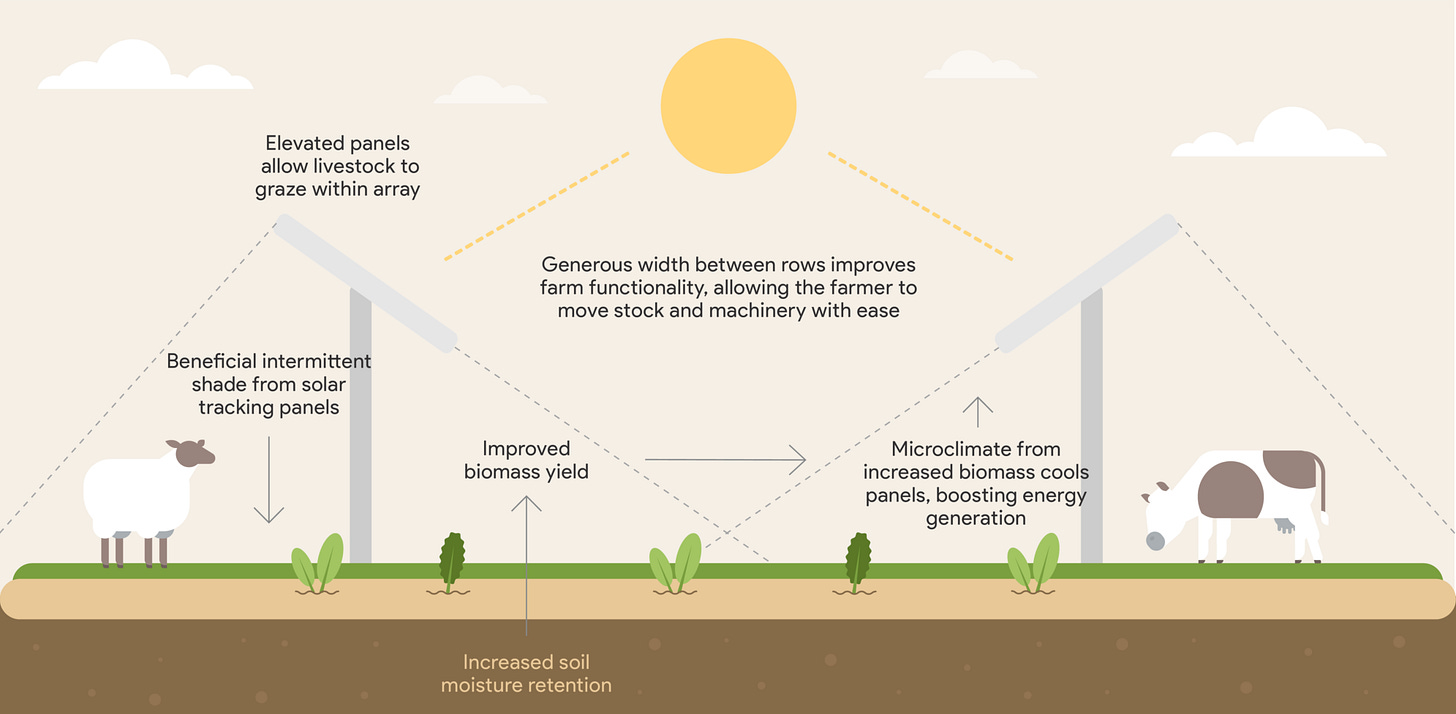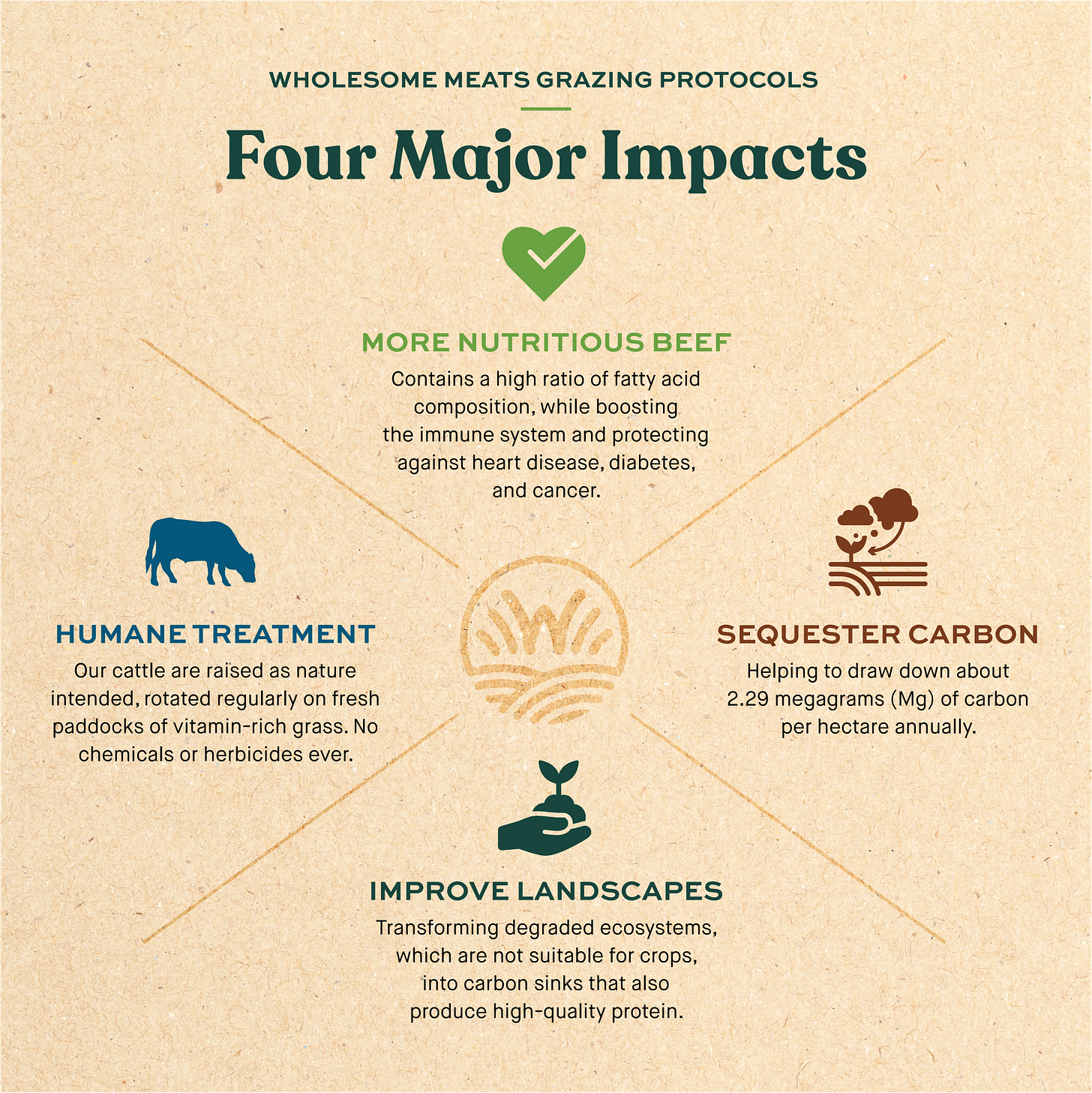🌞 Agrivoltaics: Solar farming our way out of a climate crisis
Welcome back to The Regeneration Weekly, a newsletter delivering regenerative food and agriculture news to your inbox every Friday. Not a subscriber yet?
Progress: To meet President Joe Biden’s green energy plan to move the US to carbon-free electricity by 2035, solar photovoltaic (PV) technology will likely consume a larger chunk of our nation’s energy portfolio. Yet conventional solar arrays must grapple with the problem of “energy sprawl” - the land and water area required for energy production. By 2030, an area at least the size of Minnesota may need to be converted to utility-scale solar arrays to meet the energy needs in the US alone. And because the best places for growing crops are the same areas with the highest potential for producing solar energy, a growing number of panels are being positioned on arable land - displacing current food production. Luckily, the emerging field of agrivoltaics offers a new type of dual-use solar array that can improve land productivity by 70 percent.
This method allows an agroecosystem to “harvest” the same amount of sunlight twice: as a source of renewable energy and as fuel for crops. These solar arrangements - standing at over seven feet tall - leave room for people, farming equipment, and livestock to pass or graze below. And instead of grouping them tightly together, the panels are separated by two or three-foot gaps. This choice enables natural light to filter through - promoting healthy crop growth beneath or between the rows. And with an investment of less than 1 percent of the annual US budget, agrivoltaics could lead to a reduction of 330,000 tons of carbon dioxide (CO2) emissions in the US per year - the equivalent of 75,000 cars off the road per year - and the creation of 117,000 jobs in rural communities. The cost of this hypothetical project would be approximately $1.12 trillion spread over a 35-year timeline.
While impacts vary by plant type and geography, the partial shading provided by PV panels has synergistic benefits, including:
Increasing agricultural efficiency: All crops have a light saturation point - the point at which sunlight hitting a plant increases stress and the demand for water. The shade provided by agrivoltaic systems creates a damp microclimate beneath the solar panels, which decreases the plants' need for more water and prevents soil evaporation. The placement of the arrays also allows crops just the right amount of sunlight to keep photosynthesizing at a more even rate throughout the day. And in Minnesota, solar panels are shading the cattle of a rotational grazing pasture to lower animal heat stress and power a milking parlor.
Optimizing solar energy generation: One of the challenges with traditional renewable energy production is that it induces a “heat island” effect, which raises air temperatures and causes solar panels’ efficiency to drop. By swapping out the gravel floor and concrete bases for vegetation, agrivoltaic systems can produce up to 10 percent more solar power than they would without plants growing underneath them. The plants beneath the solar arrays emit moisture during a natural process known as transpiration, which lowers the air temperature. According to a 2020 study, if agrivoltaic systems covered an area the size of Maryland (about 13,000 square miles), it would meet 20 percent of US electricity generation. It would take about 17 years to pay for the project, which would produce $35.7B in revenue.
Improving farmer profitability: As domestic growers continue to experience volatile growing seasons, unstable crop yields, and rising farm bankruptcies, many are exploring ways to diversify revenue streams and reduce overhead expenses. Through programs like virtual net metering and solar renewable energy credits, farmers can sell surplus sunlight back to the grid for consumer use. Producers also have the option to store the extra energy in battery banks for internal use. This technique can bring electricity savings, which accounts for between 1 to 6 percent of annual farm production expenses. Down the road, surplus energy could be used to power electric farm equipment and other technology that improves efficiency.
In the last decade, the National Renewable Energy Laboratory has developed more than 25 sites around the country that combine solar panels with food crops, pollinator-friendly plants, or grazing animals that manage vegetation. It is important to note that while the US has more than 71,300 megawatts of installed solar capacity, less than 5 megawatts worth of our solar arrays has crops planted beneath them. Overcoming the steep cost-to-entry for these novel tools will only follow some combination of policy, tax rebates and incentives, favorable loans, and integration into electrical grids, where farmers can profit from selling the sunlight they farm. With climate change on the rise, the co-location of solar panels and farmland is one the most promising ways to produce more food, more energy, lower carbon emissions, and more prosperous rural communities.
Watch: Inspired by Naomi Klein’s international non-fiction bestseller, This Changes Everything is a documentary reimagining the multifaceted challenge of climate change. Director Avi Lewis presents seven portraits of communities from across the world on the front lines, from Montana’s Powder River Basin to the Alberta Tar Sands, from the coast of South India to Beijing and beyond. Unlike many works about the climate crisis, This Changes Everything aims to empower rather than scare the audience into action. At the core of this film is the message that we can use our environmental catastrophe as a catalyst to transform our failed economic system into something better.
Shop: Wholesome Meats beef is raised by independent ranchers that practice regenerative agriculture and rotational cattle grazing. In celebration of Earth Week, the team is offering a “buy one, gift one” promotion to all online shoppers. For every order of ground beef or premium steak placed from April 21 - April 25th, Wholesome Meats will add a complimentary pound of ground beef and a premium steak to customers’ orders. Moreover, the planet-friendly beef brand is partnering with the US Department of Agriculture to plant a tree for every online order placed during the same window of time. Click here to view their full line of premium grass-fed and finished ground beef and steak cuts.
Disclaimer: The Regeneration Weekly receives no compensation or kickbacks for brand features - we are simply showcasing great new regenerative products.
The Regeneration is brought to you by Wholesome Meats | Soilworks | PastureMap.






